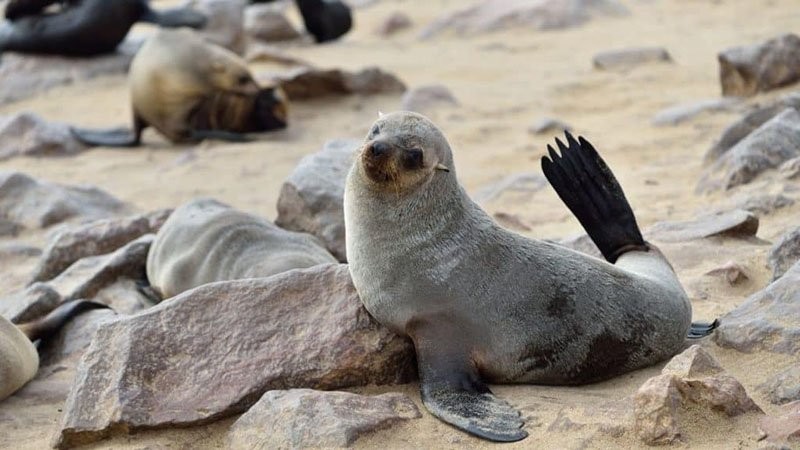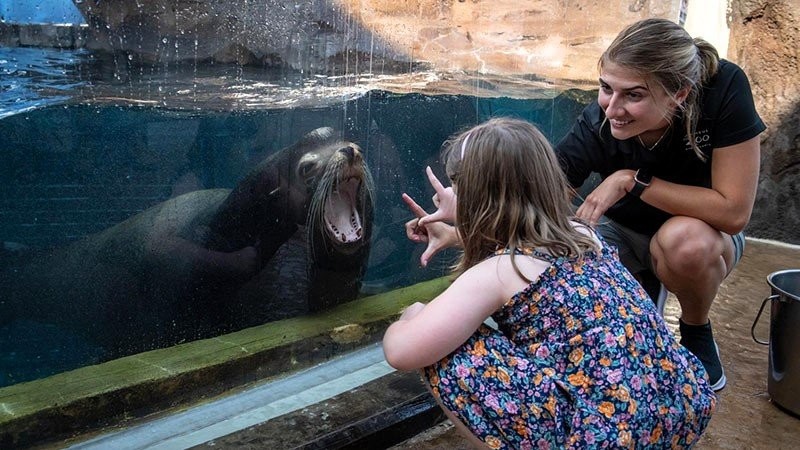Can I Have A Seal As A Pet? The allure of these playful marine mammals is undeniable, but before you dream of a flippered friend, PETS.EDU.VN wants to help you dive deep into the realities of seal ownership, from legal hurdles to ethical dilemmas. We will explore the specific needs of seals and guide you toward responsible ways to appreciate these magnificent creatures. Learn about marine mammal care, wildlife conservation, and responsible pet ownership, all in one place.
1. Discovering Seals: More Than Just Adorable Faces
Seals, fascinating marine mammals inhabiting oceans worldwide, charm us with sleek bodies and agile flippers, enabling effortless aquatic movement. Belonging to the Phocidae family within the Carnivora order, seals exhibit diverse adaptations tailored to their specific marine environments. These adaptations make them truly unique.
Unlike dolphins and whales, seals can venture onto land, often basking on beaches or rocks to rest and raise their young. Fish and other marine life form the bulk of their diet, while their playful antics and intelligence captivate observers. From size and color to habitat, seal species display a remarkable range of diversity.
Seals are wild creatures with specific needs that are difficult to meet in captivity. Their requirement for vast aquatic spaces, specialized diets, and social interaction with other seals underscores the importance of preserving their natural habitats. The challenges of keeping them in domestic settings become apparent.
Also Read: Do Owning Exotic Animals Make Good Pets?
2. Legal Landscape: Can You Keep Seals as Pets in the US?
Is it legal to own a seal? In the United States, the Marine Mammal Protection Act (MMPA) of 1972 generally prohibits keeping seals as pets, a critical piece of legislation. This federal law forbids the “take” of marine mammals, encompassing capturing, harassing, killing, or attempting to do so within U.S. waters or by U.S. citizens on the high seas. Import, export, and sale of marine mammals and their parts are also prohibited within the U.S.
Exceptions exist for scientific research, public display by qualified institutions like aquariums and zoos, and subsistence use by Alaskan Natives, all requiring specific permits and adherence to stringent regulations. These exceptions are carefully controlled.
Private ownership of seals for personal reasons falls outside these exceptions, as the MMPA aims to protect marine mammals from exploitation and maintain healthy wild populations.
Thus, personal pet ownership of seals is illegal in the United States. This law effectively prevents individuals from legally owning seals. The legal restrictions safeguard the welfare of these wild animals, preserve their natural habitats, and maintain the balance of marine ecosystems. According to the National Oceanic and Atmospheric Administration (NOAA), violations of the MMPA can result in substantial fines and even imprisonment, underscoring the seriousness with which these protections are enforced.
3. Legal Landscape: Can You Keep Seals as Pets in the UK?
Can I have a seal as a pet in the UK? The legality of keeping seals as pets in the UK is complex. No specific law explicitly prohibits seal ownership, but various regulations make it highly impractical and potentially illegal. Seals need large aquatic spaces and specific diets, and as non-domesticated animals, they are unsuitable for home environments.
Wildlife protection laws, including the Wildlife and Countryside Act, govern the welfare of wild animals and their habitats, further complicating the legality of keeping seals as pets.
The welfare and protection of wildlife, including seals, are governed by several laws in the UK. The Wildlife and Countryside Act is the most significant, protecting wild animals and their habitats. While seals are not currently listed in Schedule 5 of this Act (which would protect them from intentional disturbance), the Seal Research Trust and Parliament’s Environment, Food and Rural Affairs Committee have called for their inclusion. This would enhance legal protections for seals and potentially restrict their ownership as pets.
4. Legal Landscape: Can You Keep Seals as Pets in Australia?
Is it legal to own a seal in Australia? In Australia, the Environmental Protection and Biodiversity Conservation (EPBC) Act prohibits keeping seals as pets. This act prohibits injuring, keeping, killing, moving, taking, or trading any marine species in Australian waters, Australian Government land, or Commonwealth waters without a proper permit. State legislation may also apply, making the prospects of legally owning a pet seal in Australia generally unfavorable.
5. Practical Considerations: What You Need To Know Before Owning a Pet Seal
The practical challenges of keeping a seal are significant. They require vast aquatic spaces, and their diet, primarily fresh fish, isn’t readily available at pet stores. As non-domesticated animals, seals can be unpredictable and potentially dangerous, considering their size and strength.
Here are some essential things to consider before contemplating seal ownership:
- Size and Space: Seals are large animals needing extensive space, including a large saltwater pool and suitable land area.
- Diet: They consume approximately 5% of their body weight in fish daily, which can be costly. According to a study published in the Journal of Marine Biology, the average adult seal consumes between 10 to 20 pounds of fish per day, depending on the species and size.
- Safety Risks: Seals can be dangerous due to their strength and potential for aggression.
- Specialized Care: Caring for a seal requires specialized knowledge and resources due to their complex health and welfare needs.
- Legal and Ethical Considerations: Keeping a seal as a pet is often illegal or heavily regulated due to ethical and conservation concerns.
6. Ethical Dilemmas: The Welfare of Seals
Keeping a seal as a pet raises significant ethical concerns. As highly social, intelligent creatures, seals need interaction with their own kind. In captivity, they often suffer social deprivation, leading to behavioral problems. Moreover, many seal species are endangered, and the pet trade can exacerbate their plight.
7. Health and Safety: Risks to Humans
Owning a seal poses health risks to humans. Seals can carry diseases transmissible to humans, such as leptospirosis and salmonella, and their sharp teeth and powerful jaws can cause serious injuries. According to the Centers for Disease Control and Prevention (CDC), it is crucial to maintain strict hygiene practices when interacting with seals to prevent zoonotic diseases.
8. Social and Ecological Impacts: Beyond Individual Welfare
Removing seals from their natural habitat for the pet trade can disrupt marine ecosystems, leading to ecological imbalances. It can also harm seal populations by reducing genetic diversity and causing inbreeding. A report by the International Union for Conservation of Nature (IUCN) highlights that the removal of seals from their natural habitats can have cascading effects on the food web, impacting other marine species.
9. Alternatives to Pet Ownership: Ethical Ways to Appreciate Seals
For those captivated by seals, ethical alternatives to ownership exist. Visiting accredited zoos and aquariums or engaging in wildlife conservation efforts allows appreciation of these animals without the moral dilemmas of pet ownership.
Here are several alternatives for those interested in seals but unable to own one:
- Visiting Zoos and Aquariums: Many zoos and aquariums house seals and offer educational programs about them.
- Participating in Wildlife Tours: Guided tours in regions where seals are native can provide opportunities to observe them in their natural habitat.
- Supporting Conservation Efforts: Contributing to organizations that focus on marine conservation can be a fulfilling way to help protect seals and their environments.
- Volunteering: Some conservation projects or rescue centers may offer volunteer opportunities to work with seals or other marine life.
These alternatives allow engagement with seals without the challenges of pet ownership.
10. Unveiling Seal Biology: A Deep Dive into Species Diversity
There are about 33 recognized species of seals that belong to the Phocidae family.
| Seal Species | Habitat | Size (Average Length) | Interesting Fact |
|---|---|---|---|
| Harbor Seal | Coastal waters of the Northern Hemisphere | 5-6 feet | Known for their distinctive V-shaped nostrils. |
| Grey Seal | North Atlantic coasts | 7-10 feet | Males have a distinctive Roman nose. |
| Harp Seal | Arctic and North Atlantic oceans | 5-6.5 feet | Pups have fluffy white coats for the first few weeks of their lives. |
| Ringed Seal | Arctic and subarctic regions | 4-5.5 feet | Can maintain breathing holes in the ice using their claws. |
| Weddell Seal | Antarctic region | 8-11 feet | Can hold their breath for over an hour while diving. |
| Crabeater Seal | Antarctic region | 7-9 feet | Primarily eats krill, not crabs, despite its name. |
| Leopard Seal | Antarctic region | 8-12 feet | Known as a top predator in the Antarctic, preying on penguins and other seals. |
| Elephant Seal | Pacific and Antarctic coasts | 9-20 feet | Males have a large proboscis (nose) that amplifies their mating calls. |
| Monk Seal | Tropical and subtropical regions | 7-8 feet | One of the most endangered seal species. |
| Hooded Seal | North Atlantic and Arctic oceans | 8-10 feet | Males have a unique inflatable hood on their heads and an inflatable nasal membrane. |
| Ribbon Seal | Arctic and subarctic regions of the North Pacific | 5-6 feet | Distinctive pattern of dark fur with light-colored bands. |


This variety underscores the adaptability and resilience of seals in diverse aquatic environments.
11. Nutrition Nuggets: A Seal’s Dietary Needs
Seals primarily eat fish, squid, crustaceans, and mollusks. Their diet depends on their habitat and the availability of prey. For example, seals in the Antarctic region, like the Crabeater Seal, predominantly feed on krill, while seals in the North Atlantic, such as the Harbor Seal, consume various fish species. According to a study in Marine Ecology Progress Series, the nutritional needs of seals vary with age, size, and reproductive status, with pregnant and lactating females requiring significantly higher caloric intake.
Understanding the dietary requirements of different seal species is crucial for conservation efforts and for maintaining the health of seals in captivity.
12. Decoding Seal Behavior: What Makes Them Tick?
Seals exhibit a wide range of behaviors, including social interactions, hunting strategies, and communication methods. They often gather in large groups called colonies or rookeries, especially during breeding season. Communication occurs through vocalizations, body postures, and even slapping the water. According to research published in Animal Behaviour, seals use complex vocal signals to maintain social bonds and coordinate activities.
Understanding these behaviors is essential for their conservation and welfare, whether in the wild or in managed care.
13. Health Matters: Common Seal Ailments
Seals are susceptible to various health issues, including parasitic infections, viral diseases, and injuries from predators or human activities. Common ailments include seal pox, influenza, and respiratory diseases. Regular veterinary check-ups and appropriate preventative care are essential for maintaining their health. According to the journal Diseases of Aquatic Organisms, early detection and treatment of diseases are critical for reducing mortality rates in seal populations.
14. Seal Conservation: Protecting Our Ocean Friends
Several organizations and initiatives are dedicated to seal conservation. These efforts include habitat protection, rescue and rehabilitation programs, and research on seal populations and their threats. The Marine Mammal Center and the Seal Conservation Society are examples of organizations actively involved in seal conservation. Their work involves monitoring seal populations, mitigating human impacts, and educating the public about the importance of seal conservation.
15. Seal Training Insights: Techniques and Ethics
Seal training is commonly practiced in zoos and aquariums for educational and conservation purposes. Training methods involve positive reinforcement techniques, such as rewarding desired behaviors with food or praise. Ethical considerations are paramount, ensuring that training enhances the animal’s welfare and does not compromise its natural behaviors. The Alliance of Marine Mammal Parks and Aquariums (AMMPA) provides guidelines for ethical and responsible seal training practices.
16. Navigating Seal Habitats: Where Do They Thrive?
Seals inhabit diverse environments, from icy polar regions to temperate coastlines. Each species has adapted to its specific habitat, with unique physiological and behavioral traits. For instance, the Ringed Seal is well-adapted to Arctic environments, while the Harbor Seal thrives in temperate coastal waters. Protecting these habitats is crucial for the survival of seal populations. Conservation efforts often focus on mitigating threats such as pollution, habitat destruction, and climate change to ensure the long-term health of seal habitats.
17. The Seal-Human Connection: Myths and Realities
Seals have been featured in myths and legends across various cultures, often symbolizing transformation, adaptability, and mystery. In reality, seals are intelligent and social animals that play vital roles in marine ecosystems. Dispelling myths and promoting accurate information about seals can foster greater appreciation and support for their conservation.
18. Seal Rescue Stories: Heartwarming Tales
Numerous stories highlight the rescue and rehabilitation of seals. These tales often involve stranded or injured seals being rescued by wildlife organizations, receiving medical care, and eventually being released back into the wild. These heartwarming stories underscore the importance of conservation efforts and the dedication of individuals who work to protect these animals.
19. Future of Seals: Threats and Hope
Seals face numerous threats, including climate change, pollution, habitat destruction, and hunting. Climate change is particularly concerning, as it can lead to the loss of sea ice, which is essential for many seal species. Despite these challenges, there is hope for the future of seals. Conservation efforts, combined with increased public awareness, can help mitigate these threats and ensure the long-term survival of these magnificent marine mammals.
20. Resources for Seal Enthusiasts: Dive Deeper
For those eager to learn more about seals, numerous resources are available. Books, documentaries, websites, and educational programs offer in-depth information on seal biology, behavior, conservation, and more. The National Marine Fisheries Service (NMFS) and the Marine Mammal Center are excellent sources of information for seal enthusiasts.
FAQs – Frequently Asked Questions
1. How many seal species are there?
There are 33 recognized species of seals belonging to the Phocidae family. These species vary widely in size, habitat, and behavior, adapting uniquely to environments from the Arctic and Antarctic to temperate coastal waters.
2. Where can I buy a pet seal?
Buying a seal as a pet is generally not legal or ethical. Seals are protected under wildlife conservation laws globally and require specialized care and a habitat replicating their natural environment, which is difficult to achieve domestically. The trade and ownership of seals are regulated by international treaties and national laws in many countries.
3. What are the legal requirements for owning a pet seal in the US?
The Marine Mammal Protection Act prohibits owning seals as pets in the United States.
4. What kind of accommodations are needed for a pet seal?
Seals require large aquatic spaces, a naturalistic environment, and a diet mainly of fresh fish.
5. Can seals be good pets?
Seals are generally not suitable as pets due to their complex care requirements, large size, and natural wild behavior. They need specialized diets and expansive aquatic and terrestrial environments. Additionally, their unpredictable behavior can pose safety risks. Legal and ethical considerations also make keeping seals as pets problematic in many regions.
6. Where can I buy a pet seal?
Buying a pet seal is generally not feasible due to legal restrictions, ethical considerations, and the specialized care they require. In many regions, buying and keeping seals as pets is illegal. Moreover, obtaining a seal from a reputable source would be extremely challenging, even if it were legal, as they are not typically bred or sold for private ownership.
7. What diseases can seals transmit to humans?
Seals can transmit diseases such as leptospirosis and salmonella to humans.
8. How long can seals hold their breath?
The duration a seal can hold its breath varies by species. Some seals, like the Weddell Seal, can hold their breath for over an hour.
9. What do seals eat?
Seals primarily eat fish, squid, crustaceans, and mollusks. Their diet depends on their habitat and the availability of prey.
10. Are all seal species endangered?
Not all seal species are endangered, but some, like the Monk Seal, are among the most endangered.
Conclusion: Embracing Ethical Interaction with Seals
In conclusion, while the idea of keeping seals as pets may seem appealing, it is fraught with legal, ethical, and practical challenges. Seals are wild animals that belong in their natural habitat, not in a domestic setting. As we’ve explored on PETS.EDU.VN, their complex needs, protected status, and the potential risks they pose make them unsuitable as pets.
But that doesn’t mean you can’t appreciate and enjoy these amazing creatures! There are many ethical ways to interact with seals, such as visiting accredited zoos and aquariums, participating in wildlife tours, and supporting conservation efforts. By choosing these responsible alternatives, you can help protect seals and their natural habitats while still satisfying your fascination with these incredible marine mammals.
Ready to dive deeper into the world of animal care and responsible pet ownership? Visit PETS.EDU.VN for a wealth of information on various animal species, their unique needs, and the best ways to ensure their well-being. Whether you’re interested in marine mammals or domestic pets, we have the resources to help you become a more informed and responsible animal lover.
For more information, contact us at:
- Address: 789 Paw Lane, Petville, CA 91234, United States
- Whatsapp: +1 555-987-6543
- Website: pets.edu.vn
Come and explore more about marine wildlife, animal welfare, and conservation tips.
